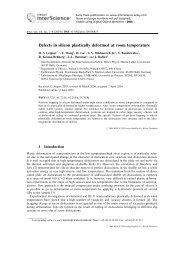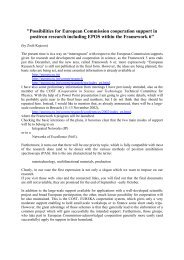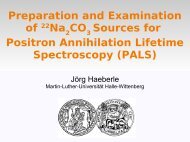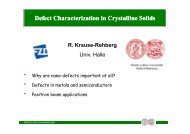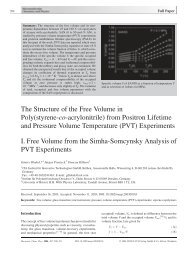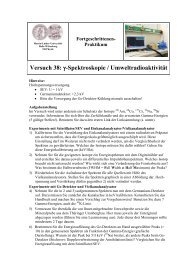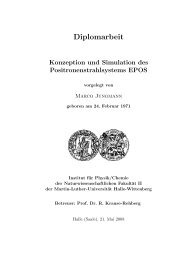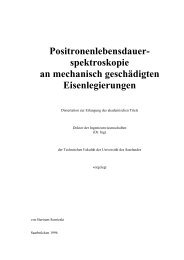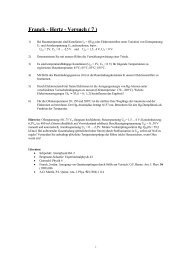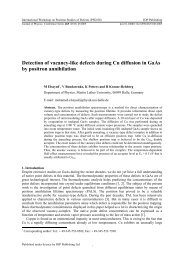Introduction into defect studies in ceramic materials(III) - Positron ...
Introduction into defect studies in ceramic materials(III) - Positron ...
Introduction into defect studies in ceramic materials(III) - Positron ...
You also want an ePaper? Increase the reach of your titles
YUMPU automatically turns print PDFs into web optimized ePapers that Google loves.
<strong>Introduction</strong> <strong><strong>in</strong>to</strong> <strong>defect</strong> <strong>studies</strong> tudies <strong>in</strong><br />
<strong>ceramic</strong> <strong>materials</strong>(<strong>III</strong>)<br />
<strong>materials</strong>(<strong>III</strong>)<br />
Structure, Defects and Defect Chemistry<br />
Z. Wang<br />
January 18, 2002
Defect Chemical Reaction<br />
1. Mass, Charge and Site Balance<br />
The Schottky reactions for NaCl and MgO, respectively, can be written<br />
us<strong>in</strong>g Kröger-V<strong>in</strong>k notation as:<br />
•<br />
null → ′ Na + Cl V V<br />
null<br />
Where null (sometimes “nil”) <strong>in</strong>dicates the creation of <strong>defect</strong>s from a<br />
perfect lattice. The respective mass-action equilibrium constants are:<br />
K<br />
K<br />
s<br />
s<br />
→ V ′<br />
Mg + VO<br />
[ ][ ] •<br />
V ′ V<br />
( 2.<br />
12)<br />
= Na Cl<br />
••<br />
The brackets denote concentration, usually given <strong>in</strong> mole fraction<br />
(equivalent to n v /N).<br />
2<br />
( 2.<br />
10)<br />
( 2.<br />
11)<br />
[ ][ ] ••<br />
V ′<br />
V<br />
( 2.<br />
13)<br />
= Mg O
Defect Chemical Reaction<br />
1. Mass, Charge and Site Balance<br />
The free energy for each of these “quasichemical” reactions is simply the<br />
Schottky formation energy, and the equilibrium constant is given<br />
by:<br />
K<br />
s<br />
⎛ ∆gs<br />
⎞<br />
= exp⎜− ⎟<br />
⎝ kT ⎠<br />
Notice that the equilibrium constant is a function of temperature only.<br />
This dictates that the product of the cation and anion vacancy<br />
concentrations (Eqs. 2.12 and 2.13) is a constant at fixed temperature.<br />
Furthermore, when only the <strong>in</strong>tr<strong>in</strong>sic <strong>defect</strong>s are present, the<br />
concentration of anion and cation vacancies must be equal for charge<br />
neutrality, and so we obta<strong>in</strong><br />
[ ] [ ] •<br />
∆gs<br />
V ′ Na = VCl<br />
= exp( − )<br />
( 2.<br />
15)<br />
2kT<br />
Which is the same result as <strong>in</strong> Table 2.1.<br />
3<br />
( 2.<br />
14)
Defect Chemical Reaction<br />
1. Mass, Charge and Site Balance<br />
(1) Rules of <strong>defect</strong> chemical reactions--mass, charge and site balance.<br />
• Mass balance simply means that a <strong>defect</strong> chemical reaction<br />
cannot create or lose mass.<br />
• Site balance means that the ratio of cation and anion sites of the<br />
crystal must be preserved, although the total number of sites<br />
can be <strong>in</strong>creased or decreased.<br />
• Charge balance means the total effective charge is balanced <strong>in</strong><br />
the Kröger-V<strong>in</strong>k notation system.<br />
(2) As example of site balance<br />
Consider the Schottky reactions for Al2O3 and BaTiO3 .<br />
Cation and anion vacancies must be formed <strong>in</strong> the stoichiometric<br />
ratios, and if so, we f<strong>in</strong>d that the effective charges are<br />
automatically balanced:<br />
••<br />
2V ′<br />
Al + 3V<br />
( Al2O3<br />
)<br />
null =<br />
O<br />
′<br />
′<br />
′ +′<br />
••<br />
null =<br />
V V 3V 4<br />
Ba + Ti O<br />
( BaTiO3<br />
)<br />
( 2.<br />
16)<br />
( 2.<br />
17)
Defect Chemical Reaction<br />
1. Mass, Charge and Site Balance<br />
The Frenkel reaction, written <strong>in</strong> Kröger-V<strong>in</strong>k notation for the system<br />
AgCl (<strong>in</strong> which this <strong>in</strong>tr<strong>in</strong>sic mechanism is dom<strong>in</strong>ant) is<br />
Site balance is ma<strong>in</strong>ta<strong>in</strong>ed here s<strong>in</strong>ce the formation of <strong>in</strong>terstitials does<br />
not create new crystal sites, but rather occupies pre-exist<strong>in</strong>g ones.<br />
Discussion:<br />
Ag = Ag + V ′<br />
x<br />
Ag<br />
• “Correctness” of <strong>defect</strong> chemical reaction.<br />
• Simultaneity of <strong>defect</strong> chemical reaction.<br />
•<br />
i<br />
Ag<br />
( 2.<br />
18)<br />
• It is the most probable reactions that are of greatest <strong>in</strong>terest, and<br />
of which there are fortunately only a few that usually need to be<br />
considered.<br />
• In addition to the formation of <strong>in</strong>tr<strong>in</strong>sic <strong>defect</strong>s, reactions of<br />
particular <strong>in</strong>terest <strong>in</strong>clude the <strong>in</strong>corporation of solutes, formation<br />
of <strong>in</strong>tr<strong>in</strong>sic electronic <strong>defect</strong>s, oxidation 5 and reduction, and <strong>defect</strong><br />
association and precipitation.
Defect Chemical Reaction<br />
2. Solute Incorporation.<br />
(1) Iso-solutes <strong>in</strong>corporation<br />
a substitutional solute of NiO <strong>in</strong> MgO.<br />
x<br />
NiO = Ni<br />
x<br />
+ O<br />
Mg<br />
and <strong>in</strong>volves no charged species.<br />
(2) Aliovalent solutes<br />
we may presume that the alum<strong>in</strong>um will substitute for magnesium. The<br />
oxygen ion are likely to occupy additional oxygen lattice. We at this<br />
po<strong>in</strong>t have<br />
• x<br />
Al2 O3<br />
= 2AlMg<br />
+ 3OO<br />
Which accounts for all of the mass <strong>in</strong>volved. However,we have satisfied<br />
neither site nor charge balance.<br />
By add<strong>in</strong>g an additional vacant magnesium site, we can correct the<br />
situation:<br />
Al O<br />
•<br />
= 2Al<br />
x<br />
+ 3O<br />
+ V ′<br />
O<br />
2 3 Mg O Mg<br />
( 2.<br />
19)<br />
and at the same time satisfy charge and site balance.<br />
Solutes greater or lesser <strong>in</strong> valence than the host must be chargecompensated<br />
<strong>in</strong> solid solution. 6<br />
( 2.<br />
20)
Defect Chemical Reaction<br />
2. Solute Incorporation.<br />
(3)As a third example, consider the <strong>in</strong>corporation of MgO <strong><strong>in</strong>to</strong> Al2O3 . In<br />
this <strong>in</strong>stance, the Mg ions may enter the solid solution<br />
substitutionally or <strong>in</strong>tersitially; it is not exactly clear which is the<br />
lower energy option. If it is substitutional, a possible reaction is<br />
x ••<br />
2MgO<br />
= 2Mg′<br />
Al + 2OO<br />
+ VO<br />
( 2.<br />
21)<br />
and if it is <strong>in</strong>terstitial, we can write:<br />
••<br />
x<br />
3MgO = 3Mgi<br />
+ 3OO<br />
+ 2V<br />
′<br />
Al<br />
( 2.<br />
22)<br />
A third possibility is that magnesium is self-compensat<strong>in</strong>g and forms<br />
both the <strong>in</strong>terstitial and substitutional <strong>defect</strong>:<br />
3MgO<br />
= 2Mg′<br />
••<br />
x<br />
+ Mg + 3O<br />
( 2.<br />
23)<br />
Al<br />
i<br />
We should confirm that mass, site, and charge balance is ma<strong>in</strong>ta<strong>in</strong>ed <strong>in</strong><br />
each of these <strong>in</strong>stances.<br />
7<br />
O
Defect Chemical Reaction<br />
2. Solute Incorporation.<br />
x •<br />
2MgO<br />
= 2Mg′<br />
Al + 2OO<br />
+ VO<br />
••<br />
x<br />
3MgO = 3Mgi<br />
+ 3OO<br />
+ 2V<br />
′<br />
Al<br />
3MgO<br />
= 2Mg′<br />
Al<br />
Discuss<strong>in</strong>g:<br />
••<br />
x<br />
+ Mgi<br />
+ 3OO<br />
( 2.<br />
23)<br />
• If the respective energies are similar, no one will be dom<strong>in</strong>ant <strong>in</strong><br />
the three cases. These reactions are simultaneously <strong>in</strong> equilibrium.<br />
• Experimental data and calculations of the relative energies for<br />
these <strong>in</strong>corporation mechanisms suggest that at high temperatures<br />
magnesium is self-compensated to a large extent, but that some<br />
m<strong>in</strong>or compensation by cation vacancies or oxygen vacancies also<br />
exists. That is, the net <strong>in</strong>corporation can be considered to be mostly<br />
reaction 2.23, plus some fraction of reactions 2.21 or 2.22.<br />
• We also emphasize that the free energy of solution for aliovalent<br />
solutes also <strong>in</strong>cludes the formation energy of the chargecompensat<strong>in</strong>g<br />
<strong>defect</strong>s.<br />
•<br />
8<br />
( 2.<br />
21)<br />
( 2.<br />
22)
Defect Chemical Reaction<br />
3. Electrons, Holes, and Defect Ionization.<br />
• “Intr<strong>in</strong>sic electronic” reaction:<br />
•<br />
null = e′<br />
+ h<br />
( 2.<br />
24)<br />
•<br />
•<br />
•<br />
•<br />
The formation energy is the band gap.<br />
When electrons and holes are tightly bound to an ion, or otherwise<br />
localized at a lattice site, the whole is considered to be ionic <strong>defect</strong>s.<br />
The valence state of <strong>defect</strong>s can be vary.<br />
Changes <strong>in</strong> valence take place via ionization reactions such as:<br />
••<br />
•<br />
V ′ O + e = VO<br />
( 2.<br />
25)<br />
• • ••<br />
Zni<br />
+ h = Zni<br />
For which equilibrium constants can be written:<br />
( 2.<br />
26)<br />
K<br />
1(<br />
2)<br />
K<br />
1(<br />
2)<br />
[ ] •<br />
VO<br />
[ V ] •<br />
O n<br />
[ ] ••<br />
Zni<br />
[ V ] h<br />
= •<br />
= •<br />
i<br />
∆g<br />
= exp( −<br />
kT<br />
1<br />
∆g<br />
= exp( −<br />
kT<br />
2<br />
)<br />
)<br />
9<br />
( 2.<br />
27)<br />
( 2.<br />
28)
Defect Chemical Reaction<br />
4. Oxidation and Reduction Reaction.<br />
Reduction Reaction<br />
• The reduction of an oxide can be written as the removal of oxygen<br />
to the gas phase leav<strong>in</strong>g beh<strong>in</strong>d oxygen vacancies:<br />
=<br />
1 ••<br />
O2(<br />
g)<br />
+ V + 2e′<br />
2<br />
x<br />
OO O<br />
The two electrons that were associated with the O2+ ion are<br />
liberated with<strong>in</strong> the solid.<br />
• The equilibrium constant for this reaction is:<br />
K<br />
2 ••<br />
1/<br />
2 0 ∆g<br />
R<br />
= n V P = K exp( − )<br />
( 2<br />
R<br />
Where the oxygen partial pressure is equivalent to oxygen activity, K R 0<br />
is a constant, and ∆g R is the free energy of reduction. The<br />
concentration of oxygen ions on their proper sites, [O O x ], is<br />
essentially unity (that is, the concentration of vacancies is assumed<br />
dilute).<br />
10<br />
( 2.<br />
29)<br />
[ ] . 30)<br />
O<br />
O<br />
R<br />
2 kT
Defect Chemical Reaction<br />
4. Oxidation and Reduction Reaction.<br />
Oxidation reaction<br />
• Oxidation can be written as the consumption of oxygen vacancies:<br />
1 2<br />
O<br />
2<br />
••<br />
x<br />
( g)<br />
+ V = O + 2h<br />
• For which the equilibrium constant is:<br />
2<br />
p<br />
0 ∆g<br />
KO<br />
= = K exp(<br />
1/<br />
2 O −<br />
••<br />
V P<br />
kT<br />
[ ]<br />
O<br />
O<br />
2<br />
O<br />
• It is important to note that s<strong>in</strong>ce oxidation and reduction are the<br />
same thermodynamic process simply reversed, the reactions that<br />
we write to describe them are not <strong>in</strong>dependent.<br />
• The equilibrium constants <strong>in</strong> Eqs.2.30 and 2.32 are also not<br />
unitless. Typically, the units will reflect whichever pressure and<br />
concentration units <strong>in</strong> use.<br />
O<br />
11<br />
•<br />
O<br />
)<br />
( 2.<br />
31)<br />
( 2.<br />
32)
Defect Chemical Reaction<br />
4. Oxidation and Reduction Reaction.<br />
There are a number of ways of writ<strong>in</strong>g the oxidation and reduction<br />
reactions, which we may choose for convenience <strong>in</strong> order to show<br />
the formation or removal of particular <strong>defect</strong>s.<br />
1 x<br />
•<br />
O2( g)<br />
= O ′<br />
O + VMg<br />
+ 2h<br />
( 2.<br />
33)<br />
2<br />
Obta<strong>in</strong>ed by add<strong>in</strong>g the Schottky reaction to Eq. 2.31. Another is<br />
1 x<br />
2( ) 2 O Mg<br />
( 2.<br />
34)<br />
2<br />
Obta<strong>in</strong>ed from the previous reaction by add<strong>in</strong>g twice the <strong>in</strong>tr<strong>in</strong>sic<br />
electronic reaction.<br />
V O e g O +<br />
′ = + ′<br />
These schemes (Eqs. 2.29-2.34) are simply alternative representations of<br />
the chemical process of oxidation, written to <strong>in</strong>clude a particular<br />
<strong>defect</strong> type. It is usually convenient to choose just one<br />
representation that <strong>in</strong>cludes the prevail<strong>in</strong>g <strong>defect</strong>s <strong>in</strong> the system.<br />
In some systems where the metal has significant vapor pressure it may<br />
be useful to write the oxidation/reduction reaction as the<br />
equilibration of the solid with the metal vapor rather than the<br />
anion vapor.<br />
12
Defect Chemical Reaction<br />
5. Intr<strong>in</strong>sic Ionic and Electronic Defect<br />
Concentrations <strong>in</strong> MgO and NaCl. NaCl<br />
The lowest energy <strong>in</strong>tr<strong>in</strong>sic <strong>defect</strong> <strong>in</strong> MgO is the Schottky pair, with an<br />
enthalpy estimated to be 7.7 eV.<br />
The bandgap is rather close <strong>in</strong> value, be<strong>in</strong>g 7.65 eV at room<br />
temperature. At 1673 K the bandgap energy is Eg ~6.28 eV.<br />
For absolutely pure and stoichiometric MgO, the Schottky <strong>defect</strong><br />
concentration is given at a high temperature of 1400 ºC by:<br />
−12<br />
= 2.<br />
5×<br />
10 mole<br />
11 −3<br />
fraction = 1.<br />
4×<br />
10 cm<br />
The electron and hole concentrations at 1673 K are given by:<br />
n=<br />
p=<br />
K<br />
1/<br />
2<br />
i<br />
[ ] [ ] ••<br />
V ′<br />
= V<br />
=<br />
Mg<br />
⎛ E ⎞<br />
⎜−<br />
2 ⎟<br />
⎝ kT⎠<br />
⎛ kT ⎞<br />
⎜ ⎟<br />
⎝2πh<br />
⎠<br />
1/<br />
2<br />
g<br />
( ) ( ∗ ∗<br />
exp 2<br />
)<br />
3/<br />
4<br />
g<br />
N N ⎜ ⎟=<br />
m m exp⎜<br />
⎟ ( 2.<br />
36)<br />
c<br />
v<br />
O<br />
=<br />
K<br />
1/<br />
2<br />
s<br />
⎛ ∆hs<br />
≈ exp⎜−<br />
⎝ 2kT<br />
13<br />
⎞<br />
⎟<br />
⎠<br />
3/<br />
2<br />
e<br />
h<br />
( 2.<br />
35)<br />
⎛ E ⎞<br />
⎜−<br />
2 ⎟<br />
⎝ kT⎠<br />
( 20 −3<br />
) 10 −3<br />
1.<br />
3×<br />
10 cm exp( −6.<br />
28eV<br />
/ 2kT)<br />
= 4.<br />
6×<br />
10<br />
n<br />
= p =<br />
cm
Defect Chemical Reaction<br />
5. Intr<strong>in</strong>sic Ionic and Electronic Defect<br />
Concentrations <strong>in</strong> MgO and NaCl. NaCl<br />
The effective masses m e * and mh * are, respectively, 0.38m0 and 0.77m 0 .<br />
We see that at this temperature, despite a considerably higher value of<br />
the Schottky <strong>defect</strong> concentration is still slightly greater than that<br />
of electrons and holes, due to the difference between the<br />
conduction band and valence band density of states(~10 20 cm -3 ) and<br />
the density of lattice sites(5.3×10 22 ).<br />
If we compare these results to a similar calculation <strong>in</strong> NaCl, which has a<br />
Schottky energy of 2.2~2.4 eV and a bandgap of 7.3 eV, it becomes<br />
apparent that anywhere below its melt<strong>in</strong>g po<strong>in</strong>t (810 ºC) the<br />
<strong>in</strong>tr<strong>in</strong>sic electronic carrier concentration <strong>in</strong> NaCl is truly<br />
<strong>in</strong>f<strong>in</strong>itesimal.<br />
At Tm , the <strong>in</strong>tr<strong>in</strong>sic electron and holes concentration are only of order<br />
104 cm-3 (~10-19 mole fraction). The Schottky <strong>defect</strong> concentration is<br />
comparatively much higher, be<strong>in</strong>g ~1 ppm (~ 10-6 mole fraction)<br />
near the melt<strong>in</strong>g po<strong>in</strong>t, due to the much smaller value of the<br />
Schottky energy. It is overwhelm<strong>in</strong>gly dom<strong>in</strong>ated by ionic <strong>defect</strong>s.<br />
14
Defect Chemical Reaction<br />
6. Electronic versus Ionic Compensation of Solutes<br />
Another important complexity <strong>in</strong> the electrical behavior of solutes <strong>in</strong><br />
ionic <strong>ceramic</strong>s arises from the existence of simultaneous equilibra.<br />
• In a covalent semiconductor such as silicon, the effectiveness of<br />
donor and acceptor solutes at a given temperature is solely<br />
determ<strong>in</strong>ed by their ionization energies.<br />
• In oxide semiconductors, the effectiveness of even shallow dopants<br />
also depends on the extent of oxidation and reduction.<br />
1. ionically compensated<br />
2. electronically compensated<br />
3. mixed compensated<br />
• This effect is of particular <strong>in</strong>terest <strong>in</strong> electronic <strong>ceramic</strong> systems,<br />
where large variations <strong>in</strong> electrical conductivity can result with<br />
changes <strong>in</strong> Po 2 and temperature at a constant dop<strong>in</strong>g level, due to<br />
changes <strong>in</strong> the compensation mechanism.<br />
Let us now consider the <strong>in</strong>corporation of Nb 2 O 5 as a solute <strong>in</strong> TiO 2 , for<br />
which both ionic and electronic compensation can occur.<br />
15
Defect Chemical Reaction<br />
6. Electronic versus Ionic Compensation of Solutes<br />
Incorporation of Nb 2 O 5 as a solute <strong>in</strong> TiO 2 :<br />
The ionic compensation of niobium is given by:<br />
• x<br />
Nb O = 4Nb<br />
+ 10O<br />
+ V ′<br />
′<br />
2 2 5 Ti O Ti<br />
The alternative electronic compensation mechanism is:<br />
• x<br />
2Nb2O5 = 4Nb<br />
+ 8O<br />
+ O2(<br />
g)<br />
+ 4e′<br />
Ti<br />
O<br />
Where one molecule of oxygen gas has been liberated upon<br />
<strong>in</strong>corporation. Which of these reactions dom<strong>in</strong>ates, and under<br />
what conditions? Notice that Eq. 2.36 and 2.37 are <strong>in</strong>terrelated by<br />
a third <strong>defect</strong> chemical reaction represent<strong>in</strong>g oxidation/reduction<br />
equilibrium, which upon subtract<strong>in</strong>g Eq. 2.37 from Eq. 2.36 is:<br />
x<br />
O ( g)<br />
+<br />
4e′<br />
= 2O<br />
+ V ′<br />
′<br />
2 O Ti<br />
Exam<strong>in</strong><strong>in</strong>g Eqs. 2.36-2.38, one f<strong>in</strong>ds that the prevail<strong>in</strong>g compensation<br />
mechanism will depend on solute concentration, oxygen pressure,<br />
and temperature.<br />
16<br />
( 2.<br />
36)<br />
( 2.<br />
37)<br />
( 2.<br />
38)
Defect Chemical Reaction<br />
6. Electronic versus Ionic Compensation of Solutes<br />
1. The oxidation reaction <strong>in</strong> Eq. 2.38 tends toward the right at higher<br />
oxygen pressure and lower temperature.<br />
2. Thus niobium tends to be compensated by titanium vacancies when<br />
the niobium concentration is high, temperature low, and oxygen<br />
pressure high.<br />
3. In the band gap scheme, ionic compensation is the condition where<br />
the niobium donor is completely compensated by the vacancy<br />
acceptor.<br />
• At lower concentrations, higher temperature, and lower oxygen<br />
pressure, the compensat<strong>in</strong>g <strong>defect</strong> is the electron. This corresponds<br />
to the <strong>in</strong>troduction of niobium donor levels <strong>in</strong> the energy gap<br />
without compensat<strong>in</strong>g ionic <strong>defect</strong>s.<br />
• x<br />
Nb O = 4Nb<br />
+ 10O<br />
+ V ′<br />
′<br />
2 2 5 Ti O Ti<br />
• x<br />
2Nb2O5 = 4Nb<br />
+ 8O<br />
+ O2(<br />
g)<br />
+ 4e′<br />
Ti<br />
O ( g)<br />
+<br />
4e′<br />
= 2O<br />
+ V ′<br />
′<br />
2<br />
x<br />
O Ti<br />
17<br />
O<br />
( 2.<br />
36)<br />
( 2.<br />
37)<br />
( 2.<br />
38)
Defect Chemical Reaction<br />
6. Electronic versus Ionic Compensation of Solutes<br />
18
Simultaneous Defect Equilibria:<br />
Equilibria<br />
The Brouwer Diagram<br />
We have now discussed a wide variety of <strong>in</strong>dividual <strong>defect</strong> reactions<br />
that can occur <strong>in</strong> a solid.<br />
Let’s consider the net effect when all of these reactions take place<br />
simultaneously!<br />
• S<strong>in</strong>ce any one <strong>defect</strong> can participate <strong>in</strong> a number of <strong>defect</strong><br />
reactions, <strong>in</strong> a real system multiple <strong>defect</strong> equilibria will occur.<br />
• In order to determ<strong>in</strong>e the <strong>defect</strong> concentrations, we must<br />
simultaneously solve a number of <strong>defect</strong> reactions.<br />
• In pr<strong>in</strong>ciple, the number of <strong>defect</strong> reactions that can be written for<br />
any system is nearly limitless; to account for all of them would<br />
appear to be a daunt<strong>in</strong>g task.<br />
• Fortunately, the number of <strong>defect</strong>s that must be <strong>in</strong>cluded for an<br />
adequate description of <strong>defect</strong>-related properties <strong>in</strong> a system is<br />
usually small.<br />
• Which <strong>defect</strong>s are important? The majority <strong>defect</strong>s are always<br />
important; but <strong>in</strong> addition, certa<strong>in</strong> m<strong>in</strong>ority <strong>defect</strong>s may have<br />
direct relevance to a property of <strong>in</strong>terest, such as the electrical<br />
conductivity. Conversely, <strong>in</strong> a small band gap compound where<br />
electronic <strong>defect</strong>s dom<strong>in</strong>ate, m<strong>in</strong>ority 19 ionic <strong>defect</strong>s rema<strong>in</strong><br />
important for diffusional processes.
Simultaneous Defect Equilibria:<br />
Equilibria<br />
The Brouwer Diagram<br />
Most often we are <strong>in</strong>terested <strong>in</strong> the variation of <strong>defect</strong> concentration<br />
with temperature, solute concentration, and ambient gas activity<br />
(usually Po 2 ). The <strong>defect</strong> formation reactions of <strong>in</strong>terest will<br />
generally <strong>in</strong>clude those for:<br />
1. Predom<strong>in</strong>ant <strong>in</strong>tr<strong>in</strong>sic ionic <strong>defect</strong>s (Schottky or Frenkel).<br />
2. Intr<strong>in</strong>sic electronic <strong>defect</strong>s.<br />
3. Oxidation and reduction.<br />
4. Incorporation of any significant solutes or impurities.<br />
These reactions will <strong>in</strong>volve a total of N <strong>defect</strong>s, the concentrations of<br />
which are N variables to be solved for. If we are careful to write<br />
only <strong>in</strong>dependent reactions, one f<strong>in</strong>ds that the equilibrium<br />
constants for the above reactions always result <strong>in</strong> (N-1)<br />
<strong>in</strong>dependent equations.<br />
20
Simultaneous Defect Equilibria:<br />
Equilibria<br />
The Brouwer Diagram<br />
For MgO, there are four <strong>defect</strong>s of <strong>in</strong>terst • •<br />
•,<br />
for<br />
which the relevant <strong>defect</strong>-form<strong>in</strong>g reactions V ′ are: ′<br />
Mg , VO<br />
, e and h<br />
null Mg O V V → ′′ + ′′<br />
•<br />
null = e′<br />
+ h<br />
x 1 ••<br />
OO = O2(<br />
g)<br />
+ VO<br />
+ 2e′<br />
With the respective equilibrium 2 constants:<br />
K<br />
s<br />
Ki = np<br />
( 2.<br />
39)<br />
[ ] 2 ••<br />
1/<br />
2<br />
K R = n VO<br />
PO<br />
( 2.<br />
30)<br />
2<br />
one additional equation is always necessary. This is provided by the<br />
requirement of bulk electrical neutrality.<br />
21<br />
( 2.<br />
11)<br />
( 2.<br />
24)<br />
( 2.<br />
29)<br />
[ ][ ] ••<br />
V ′<br />
V<br />
( 2.<br />
13)<br />
= Mg O<br />
[ ] [ ] ••<br />
′<br />
+ n = 2 V +<br />
( 2.<br />
40)<br />
2 P<br />
VMg O
Simultaneous Defect Equilibria:<br />
Equilibria<br />
The Brouwer Diagram<br />
In order to solve for all <strong>defect</strong> concentrations, one additional equation is<br />
always necessary. This provided by the requirement of bulk<br />
electrical neutrality. In the electroneutrality condition each <strong>defect</strong><br />
contributes a charge equal to its concentration times the effective<br />
charge per <strong>defect</strong>. In the current example this is:<br />
[ ] [ ] ••<br />
′<br />
+ n = 2 V +<br />
( 2.<br />
40)<br />
2 P<br />
VMg O<br />
This system of equations can now be solved to give the concentration of<br />
each <strong>defect</strong> at any temperature and Po 2 of <strong>in</strong>terest, provided that<br />
the equilibrium constants.<br />
Note that neutral <strong>defect</strong>s are not <strong>in</strong>cluded <strong>in</strong> the electroneutrality<br />
condition. Their concentration can nonetheless vary with<br />
temperature, solute concentration, and oxygen pressure through<br />
ionization and association reactions <strong>in</strong>volv<strong>in</strong>g charged <strong>defect</strong>s.<br />
Solv<strong>in</strong>g this set of simultaneous equations us<strong>in</strong>g the electroneutrality<br />
condition (Eq. 2.39) is usually a fairly straightforward procedure<br />
of solv<strong>in</strong>g s polynomial.<br />
22
Simultaneous Defect Equilibria:<br />
Equilibria<br />
The Brouwer Diagram<br />
Brouwer approximation<br />
• There is just one positive <strong>defect</strong> and one negative <strong>defect</strong>.<br />
• This assumption is valid when a s<strong>in</strong>gle <strong>defect</strong> of each sign has a<br />
concentration much higher than others of the same sign.<br />
• This condition is often satisfied due to the strong (exponential)<br />
dependence of <strong>defect</strong> concentration on T and formation energy.<br />
• For pure MgO, four Brouwer approximations are <strong>in</strong> pr<strong>in</strong>cipal<br />
possible:<br />
(1) n<br />
••<br />
2 V<br />
(2)<br />
(3)<br />
2[<br />
V ′<br />
] Mg = p<br />
[ ] [ ] ••<br />
V ′ = V<br />
′ O<br />
Mg<br />
[ ]<br />
= O<br />
(4) n=p<br />
Only one of the last two of these will be important, depend<strong>in</strong>g on the<br />
relative values of the Schottky energy and the band gap.<br />
23
Simultaneous Defect Equilibria<br />
Brouwer approximation<br />
In MgO, we found earlier:<br />
1. The Schottky concentration (3) is higher than the electronic<br />
carrier concentration (4) at high temperature.<br />
2. For simplicity, consider (3) to be dom<strong>in</strong>ant, <strong>in</strong> which case there<br />
are only three Brouwer regimes to be considered, those def<strong>in</strong>ed<br />
by (1), (2), and (3).<br />
3. Each of these regimes will be represented by a different range of<br />
oxygen activity.<br />
• S<strong>in</strong>ce reduction raises the concentration of oxygen vacancies<br />
and electrons (Eq.2.29), Brouwer approximation(1) is likely to<br />
be important at the lowest range of oxygen pressure.<br />
• Conversely, at high oxygen pressures the electron concentration<br />
is suppressed and the hole concentration p <strong>in</strong>creases (K i =np).<br />
Brouwer approximation (2) may the apply.<br />
24
Simultaneous Defect Equilibria<br />
Brouwer Diagram<br />
• The Brouwer diagram (also referred to as a Kröger-V<strong>in</strong>k<br />
diagram) is a convenient way to represent the variation <strong>in</strong> <strong>defect</strong><br />
concentrations with changes <strong>in</strong> the activity of a component of<br />
the compound, usually oxygen pressure.<br />
• It is a plot of log [concentration] aga<strong>in</strong>st log Po2 show<strong>in</strong>g<br />
variations <strong>in</strong> <strong>defect</strong> concentrations at constant temperature <strong>in</strong><br />
different Brouwer regimes.<br />
• The Brouwer diagram for a b<strong>in</strong>ary metal oxide such as MgO is<br />
shown <strong>in</strong> Fig. 2.10. Consider the regime def<strong>in</strong>ed by the Brouwer<br />
••<br />
1/<br />
2<br />
approximation [ V ′<br />
.<br />
Mg ] = [ VO<br />
] = K s<br />
1/<br />
2<br />
1/<br />
2<br />
• Note that Ki<br />
lies below K s s<strong>in</strong>ce electronic <strong>defect</strong>s are <strong>in</strong> the<br />
m<strong>in</strong>ority.<br />
• Rearrang<strong>in</strong>g Equation 2.30, we obta<strong>in</strong> the Po2 dependence of<br />
the electron concentration:<br />
1/<br />
2 −1/<br />
4<br />
n<br />
= K R K s PO<br />
−1/<br />
4<br />
2<br />
25<br />
( 2.<br />
41)
Simultaneous Defect Equilibria:<br />
Equilibria<br />
Brouwer Diagram<br />
And upon tak<strong>in</strong>g the logarithm of both sides, we have<br />
• In the central region of Fig. 2.10, the l<strong>in</strong>e represent<strong>in</strong>g n therefore has a<br />
slope of –1/4. S<strong>in</strong>ce np=K i and is constant at fixed temperature, the hole<br />
concentration follows a Po 2 dependence opposite to that of the electron<br />
concentration:<br />
p<br />
1<br />
log log O<br />
4<br />
P<br />
n − ∝<br />
=<br />
K<br />
n<br />
i −1/<br />
2 1/<br />
4 1/<br />
4<br />
= Ki<br />
K R K s PO<br />
2<br />
( 2.<br />
42)<br />
And show a +1/4 slope on the Kröger-V<strong>in</strong>k diagram.<br />
••<br />
• With sufficient reduction, the Brouwer approximation n=2 [ VO<br />
] may come<br />
<strong><strong>in</strong>to</strong> play; this is the leftmost region of Fig. 2.10. By substitut<strong>in</strong>g the<br />
Brouwer approximation <strong><strong>in</strong>to</strong> Eq. 2.30 and rearrang<strong>in</strong>g, one obta<strong>in</strong>s<br />
••<br />
and both n and VO<br />
show a –1/6 slope, displaced from one another by a<br />
factor of log 2. L<strong>in</strong>es for p and [ V ′′ Mg ] show the opposite slope, be<strong>in</strong>g<br />
••<br />
coupled to n and [ V ] through the <strong>in</strong>tr<strong>in</strong>sic electronic and Schottky<br />
O<br />
equilibra (Eq.2.13).<br />
27<br />
2<br />
[ ] • •<br />
1/<br />
3 −1/<br />
6<br />
V = ( 2K<br />
) P<br />
( 2.<br />
43)<br />
n = 2 O<br />
R O<br />
[ ]<br />
2
Simultaneous Defect Equilibria:<br />
Equilibria<br />
The Brouwer Diagram<br />
• With <strong>in</strong>creas<strong>in</strong>g Po2 the hole concentration p <strong>in</strong>creases, until<br />
the Brouwer approximation 2 [ V ′′ Mg ] =p comes <strong><strong>in</strong>to</strong> play. In this<br />
regime, substitution of the Brouwer approximation <strong><strong>in</strong>to</strong> the<br />
set of Eqs.2.13, 2.39, 2.30 results <strong>in</strong> the +1/6 slopes <strong>in</strong> Fig.<br />
2.10.<br />
p<br />
=<br />
3<br />
2/<br />
3 −1/<br />
3 1/<br />
3 1/<br />
6<br />
2K i K R K s PO<br />
[ ]<br />
••<br />
• Notice that at all times V and [ V ′′<br />
O<br />
Mg ] are symmetric about the<br />
horizontal l<strong>in</strong>e given by K 1/2<br />
s , and n and p about Ki<br />
1/2 . This is<br />
required by the Schottky and <strong>in</strong>tr<strong>in</strong>sic electronic equilibria.<br />
Discussion:<br />
1. Not all of these may be relevant to real <strong>defect</strong> behavior.<br />
2. The experimentally accessible range of Po 2 may only cover<br />
one or two Brouwer regimes.<br />
28<br />
2
Simultaneous Defect Equilibria:<br />
Equilibria<br />
The Brouwer Diagram<br />
29
The Brouwer Diagram<br />
Fig. 2.13 shows a<br />
more complex<br />
diagtam which<br />
represents the<br />
b<strong>in</strong>ary metal<br />
oxide <strong>in</strong> Fig. 2.10<br />
when it is<br />
(<br />
•<br />
1/<br />
2 [ F ] > K )<br />
M<br />
dom<strong>in</strong>ated by<br />
trivalent<br />
impurities<br />
. Defect associates<br />
are <strong>in</strong>cluded <strong>in</strong><br />
this diagram, but<br />
the m<strong>in</strong>ority<br />
s<br />
30



